|
| | The Universal Serial Bus is not universal. However, it offers
advantages that may make it well worth consideration. One of these is so
called, "Hot Swapping," where devices on the bus may be connected and
disconnected from the host PC while power is applied, without concern about
damage to either the PC or the USB device. Another is "Plug and
Play" operation. Thus, a USB device is automatically detected when it
is connected. If the proper device drivers have been installed, the USB
device automatically becomes available. USB devices do not occupy a PC bus
slot, nor do they require that the user open the PC to connect them. This
makes them attractive in a number of applications, especially ones that might
use a notebook computer. USB offers high raw data rates (as high as 12M bytes
per second in current incarnations). The actual acquisition sample rate is, of course,
dependent on much more than the raw serial bus speed. Here is an article from
Test and Measurement World on the subject. USB
Proves Ready for T&M Tasks. A more recent and in-depth article is
from Evaluation Engineering titled,
Using USB as a Data Acquisition Interface.
Low-cost (under $100) options are Phidgets:
1011 -
PhidgetInterfaceKit 2/2/2 and 1046
- PhidgetBridge
4-Input with two and four inputs, respectively, and DLP Design:
DLP-IO8-G 8-Channel Data Acquisition Board,for
only $30 - very low cost, but with modest performance.
A fairly high
performance USB based data acquisition system is from DATAQ
Instruments. Their DI-720 and DI-730 portable units range in
price from US$1200 to US$3200. IOTech USB
Data Acquisition Modules Models /55 and /56 come with software that includes
drivers for Visual Basic. Prices range from US$700 to US$1000. Here
is an article from Evaluation Engineering magazine that discusses some features
of USB data acquisition by an IOTech representative. Connecting
With the New Universal Serial Bus Data
Translation DT9800 series USB data acquisition modules range in price from
US$900 to US$1200. Domain Technologies
has two USB products. Audio4-5410 and Audio4-USB. These use Motorola
DSPs. Primary applications are in the fields of acoustic and audio
measurement and analysis, speech processing, vibration measurement and analysis,
3-D sound, signal synthesis, and applications requiring portable field based
data acquisition and measurement.
Lawson Labs has two USB products. The
Model 301 is a complete, Delta-Sigma high-resolution data acquisition system. It
serves as a general purpose A/D converter or as a built-in interface for a wide
variety of instrumentation. Up to 32 Model 301s can be connected to a single USB
port using inexpensive hubs. Two analog input channels are provided, along with
eight digital inputs and eight digital outputs. The Model 302 is a
complete, Delta-Sigma high-resolution data acquisition system. It serves as a
general purpose A/D converter or as a built-in interface for a wide variety of
instrumentation. Up to 32 Model 302s can be connected to a single USB port using
inexpensive hubs. Six analog input channels are provided, along with four
digital inputs and eight digital outputs.
Arbor Technology Co sells a
high-performance USB DAC module, the uDAC-800. It has 16 single-ended/8
differential inputs with 12-bit resolution. It supports up to 250K S/s
throughput, and up to 330K sample rate. It has dual 12-bit analog outputs,
16 digital I/O lines, and a general-purpose timer/counter.
IPC Systems
Limited (UK) sells Personal Daq/3000 with these features: 1-MHz,
16-bit multifunction, Synchronous analogue input, analogue output, digital I/O,
and counter/timer I/O, 8 differential or 16 single-ended analogue inputs
(software selectable per channel), Thermocouple inputs on any of the 8
differential inputs, expandable up to 64SE/32DE analogue inputs, Up to four
16-bit, 1-MHz analogue outputs, 24 high speed digital I/O lines, Four 32-bit
counter input channels with quadrature encoder capability.
LabJack. LabJacks are USB/Ethernet
based measurement and automation devices which provide analog inputs/outputs,
digital inputs/outputs, and more. They serve as an inexpensive and easy to use
interface between computers and the physical world. Example code is
provide in several forms (C++, VB6, VBA, etc.). Some of their products:
 | LabJack U3: USB DAQ device with up to 16 12-bit analog inputs, up to 20
digital I/O, up to 2 8-bit analog outputs, up to 2 counters, and up to 2
timers. |
 | LabJack UE9: USB/Ethernet DAQ device with 14 analog inputs (12- to
16-bit), 2 analog outputs (12-bit), 23 digital I/O, 2 counters, and 6
timers. 8 of the digital I/O can be configured on the fly as up to 6 timers
and 2 counters. |
 | LabJack UE9-Pro: All the features of the normal UE9 with the addition of
an auxiliary low-speed hi-resolution (24-bit) sigma-delta ADC. |
 | LabJack U12: USB DAQ device with 8 12-bit analog inputs, 2 analog
outputs, 20 digital I/O, and a 32-bit counter. |
 | additional accessories are available. |
Measurement Computing (now owned by National Instruments, but operating as a
separate company).
USB-1208FS Personal Measurement Device™ has these
features:
 | 8 A/D channels, 12-bit resolution |
 | 8 analog inputs (4 differential or 8 single-ended), 2
10-bit analog outputs |
 | Sample rates to 50 ksamples/sec (aggregate)
|
 | 16 DIO bits, one counter |
 | 1 sync input/output for synchronizing data
acquisition between two devices |
 | Fully compatible with LabVIEW,™ SoftWIRE®.
It comes with Universal Library™ C++, VB, VB .NET and C# routines (with source) |
 | Comes with TracerDAQ a nice oscilloscope/charting
package designed specifically for use with the USB-1208FS |
 | The PMD-1208FS may be used for a wide variety of data acquisition applications.
Compatible with USB 1.1 and 2.0 (Windows XP is suggested for optimal
performance) |
 | Cost is about $149 (less in quantity) |
I have significant experience with the USB-1208FS. I
designed it into a manufacturing PCB test system. The test system
evaluates several operational parameters that require the measurement of the
test PCB power consumption under three operational conditions, quiescent (when
power supply current should be less than about .01 mA, during a general
housekeeping session (when power supply current should be between 1 and 2 mA for
a duration of 1-2 mS) and during transmit when the RF system is uploading data
to a remote receiver (when power supply current should be between 15 and 25 mA
for a duration of 1-2 mS). The PCB test fails if the quiescent
current is too high, or if either housekeeping or transmit currents fall outside
of their specified ranges, or if the total current consumption is continuously
high, which indicates a processor bus-fault on the PCB. These devices are
battery powered in an encapsulated housing, so current consumption is a primary
concern.
I selected the USB-1208FS because the sample rate was
sufficient to measure the pulse durations and repetition rates of interest and
because the 12-bit dynamic range provided was just sufficient to measure the
quiescent current consumption while also allowing the measurement of both
transmit and high-level fault currents. Naturally, there is more involved
in the total testing environment than I've described here, but this may give you
a flavor of how such a device might be applied. If you have questions or
comments please contact me by email.
Here is a screen shot of the tester in action.
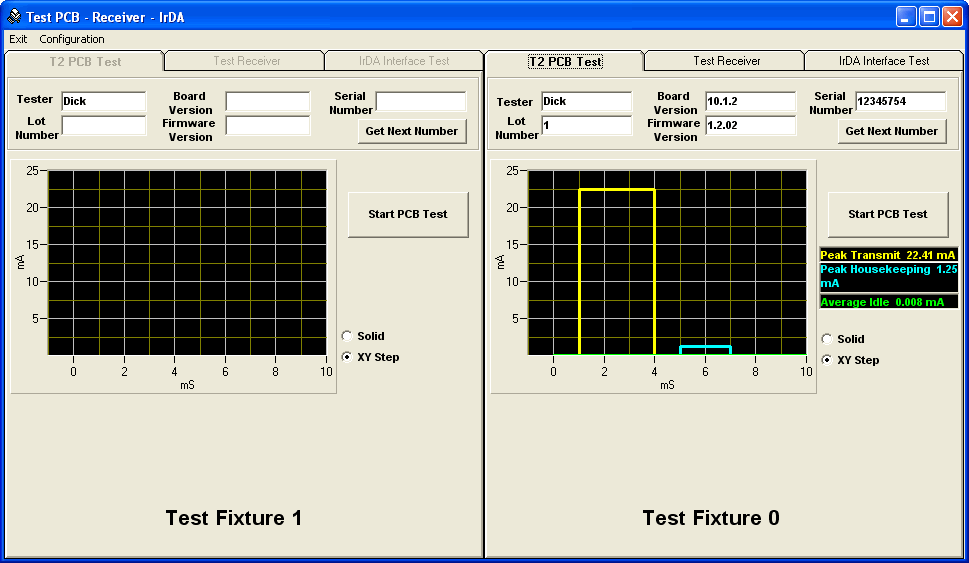
If your performance requirements a not as high, consider
the Measurement Computing USB-1208LS. It has these
features:
 | 8 A/D channels, 12-bit resolution |
 | 8 analog inputs, 2 analog outputs |
 | Sample rates to 1.2 ksamples/sec (8kS/s for 4000
samples) |
 | 16 DIO bits, one counter |
 | Fully compatible with LabVIEW,™ SoftWIRE®, and
Universal Library™ C++ routines , VB, VB .NET and C# (with source) |
 | The PMD-1208LS may be used for a wide variety of
data acquisition applicationss.
Compatible with USB 1.1 and 2.0 |
 | Cost is about $100 (less in quantity) |
Pulse/Event Counter

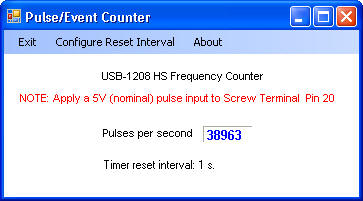
I've often been asked how to implement an event (pulse) counter. If the
pulse repetition rate exceeds about 100 pps, then you need to use external
hardware. Here is an example that uses the 1208 FS. The maximum
practical repetition rate is about 42K pps, which would meet many industrial
needs. This project uses VB 2008 (the Express version is fine).
Download the source code here.
Here is another Measurement Computing based project
that I have completed.
The requirements for this project were comparatively
low-speed analog data acquisition on five analog channels (fewer than 10 samples
per second), and the system also had to control a number of solenoid operated
valves to sequence toxic gasses through the system under test. For this
purpose the
Measurement Computing miniLab 1008 was selected for data acquisition and
control, and the
Measurement Computing SSR-RACK08 added for isolated relay drivers to be used
to drive the solenoid operated valves. The following three figures show
the simple user interface that drives testing using SO2 and CCl4 gasses to
validate the characteristics of carbon filters that are used in industrial
processes and safety applications, such as gas masks.
The basic operation sequence is
- Turn on the SO2 supply to all cartridges to be
tested and select cartridge 1 output as input to the SO2 analyzer.
Sample the SO2 concentration and other system values for the configured
interval (perhaps 60 seconds). Record the results to a log file for
cartridge 1.
- Switch SO2 analyzer input to cartridge 2 and allow
the contaminants to clear the analyzer stream (perhaps 5 seconds).
Then repeat the process in step 1 for recording sample data to a log file
for cartridge 2.
- Switch the analyzer to cartridge 3 (and
subsequently to cartridge 4), while repeating the recording process to log
files for cartridge 3 then cartridge 4.
- If the SO2 concentration from the analyzer exceeds
the configured threshold, terminate the test for that particular cartridge
and close the associated log file.
- Repeat all steps until the SO2 concentration has
exceeded the target threshold for all cartridges.
The CCl4 test is done to meat an appropriate ASTM
standard for testing carbon filter cartridges. The CCl4 test is run for a
specific time interval, then it terminates automatically.
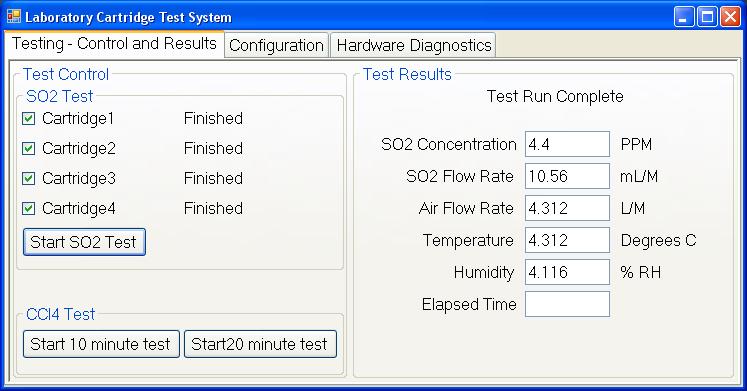
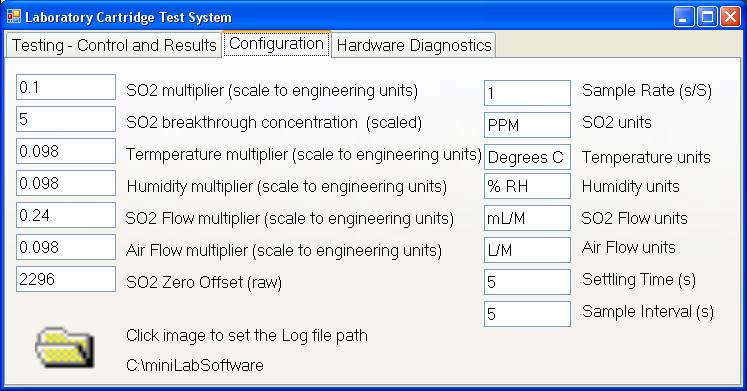
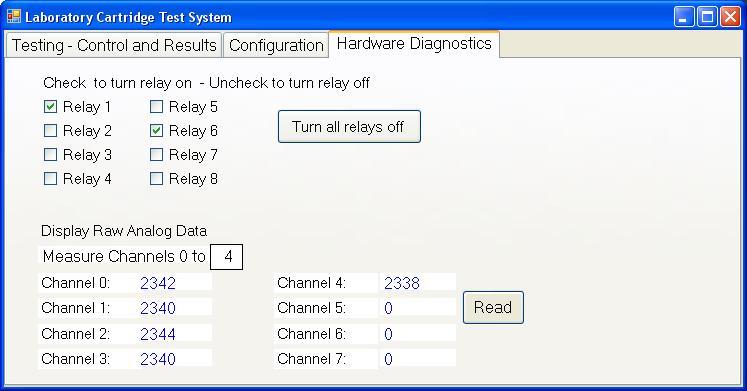
For more information on these projects, or to discuss similar applications
for your own systems, you can
contact me directly.
National Instruments
DAQPad-6015, DAQPad-6016 (16 analog input, 32 digital I/O, 2 analog
output, 2 counter/timers - 200K samples/s), and NI
USB-9215 (four channels of isolated simultaneously sampled analog input,
16-bit/24-bit resolution) are new in the Summer of 2004. Additional USB
units have been added to the NI line during 2005.
Capital Equipment Corp offers the
usbDAQ108 (12-bit resolution, 8-analog input channels, two analog outputs, and
12 digital IO lines, up to 10 K samples/sec) and the usbDAQ109 (14-bit
resolution and up to 48 K samples per second) at $145 and $245 respectively.
Pico Technology has a line of PC
oscilloscope and data acquisition products (USB is the most common interface
provided). SDKs and examples for Visual Basic and other languages are
provided for many of these devices.
Pico PC-based digital oscilloscopes offer all the functionality of
traditional test equipment (digital storage oscilloscope, spectrum
analyzer, meter and data logger), and also many features not
normally available in this price range. By integrating several
instruments into one small unit, PC oscilloscopes (PCOs)
are lighter and more portable than traditional test equipment. When
used with a notebook computer, field engineers can carry a complete
electronics lab in their PC.
 | Compact and portable units
|
 | Uses your PC monitor to provide a large and detailed color
display
|
 | Signal storage is limited only by the PC's storage
capability |
 | Captured waveforms and instrument settings can easily be
shared with others
|
 | New functionality through free software upgrades
|
 | Can be used with desktop or laptop PCs
|
 | Hardware and software in one package: no compatibility
problems or complex set up procedures
|
 | Units are also supplied with
PicoLog data logging software, which transforms your PC into
a high speed data
logger |
Pico Data Loggers:
By connecting suitable sensors, Pico data acquisition
products can be used to measure temperature, pressure,
relative humidity, light, resistance, current, power,
speed, and vibration. Pico data loggers are supplied
complete with PicoLog — this powerful but flexible
data acquisition software allows you to collect,
analyze and display data. With PicoLog the data is
viewable both during and after data collection, in both
spreadsheet and graphical format. If required, the data
can also be exported to other applications.
|


